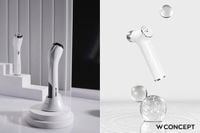Beauty device sales are soaring, driven by a booming home beauty trend that shows no signs of slowing down. On July 15, 2025, fashion platform W-Concept revealed that sales of beauty devices in the first half of this year have skyrocketed by 80% compared to the same period last year. This surge reflects a growing consumer appetite for at-home skincare and haircare solutions, underpinned by advances in technology and a shift in lifestyle preferences.
Analyzing sales data from January to June 2025, W-Concept found that the demand for both facial and hair care devices has surged dramatically. Sales of facial care devices, which target skin elasticity, moisturizing, pore improvement, and cleansing, rose by 70%. Even more striking was the 120% increase in sales of hair care devices, which include tools for hair styling, scalp care, and hair loss management. These figures highlight a comprehensive embrace of beauty tech that addresses a wide spectrum of personal care needs.
Popular brands leading this charge include LG Pra.L, DualSonic, QuadSerra, and Cellology. These brands have successfully captured consumer interest by focusing on differentiated technology and continuous research and development, which W-Concept credits as key drivers behind the sustained rise in demand. According to a W-Concept representative, "Domestic brands' differentiated technology and ongoing R&D have steadily increased the demand for beauty devices." This emphasis on innovation is clearly resonating with consumers eager for effective, convenient beauty solutions at home.
The surge in beauty device sales is particularly pronounced among consumers in their 20s and 30s, demographics known for their high engagement with beauty trends. Sales to customers in their 20s increased by 55%, while those in their 30s jumped by an impressive 75%. This trend underscores how younger adults are increasingly investing in personal care technologies, blending convenience with the desire for professional-quality results without salon visits.
Moreover, the average purchase amount per person for skin care devices has climbed by 10% compared to last year, reaching approximately 210,000 Korean won (about $160). This rise in spending per customer signals not only growing interest but also a willingness to invest more in premium beauty devices. It suggests consumers are prioritizing quality and efficacy, viewing these devices as worthwhile investments in their skincare routines.
To capitalize on this momentum, W-Concept is currently hosting a "Beauty Festa" event, running until July 20, 2025. During this special promotion, customers can purchase exclusive awards special sets featuring top-selling products like the LG Pra.L Multi-core, DualSonic Intensive Ultrasonic Effect Beauty Device, and QuadSerra Water Gloss Package at discounts of up to 30%. These deals aim to further fuel consumer enthusiasm and make cutting-edge beauty tech more accessible.
The home beauty trend reflects broader shifts in consumer behavior amplified by recent years' lifestyle changes. As people spend more time at home, they have sought ways to maintain and enhance their appearance without frequenting salons or clinics. Beauty devices offer a perfect solution, combining convenience with technological sophistication. With brands continuously innovating, these devices are becoming more effective and user-friendly, encouraging wider adoption.
Industry observers note that this growth is not just a passing fad but part of a longer-term transformation in how consumers approach beauty and self-care. The integration of technology into daily routines is reshaping expectations and creating new opportunities for brands and retailers alike. W-Concept's success in leveraging these trends through curated product selections and targeted promotions illustrates the potential of this evolving market.
Interestingly, the surge in search volumes for beauty devices, which increased tenfold, mirrors the sales growth, indicating heightened consumer curiosity and research before purchase. This pattern suggests that education and information availability play crucial roles in driving adoption, as consumers seek to understand the benefits and proper use of these devices.
In summary, the home beauty trend has propelled beauty device sales to new heights in South Korea, with W-Concept at the forefront of this surge. With sales up 80% year-over-year and strong growth across both facial and hair care categories, the market is clearly responding to consumer demand for innovative, effective, and convenient beauty solutions. As younger consumers lead the charge and spending per customer increases, the beauty device sector looks poised for continued expansion, fueled by technology, lifestyle shifts, and savvy retail strategies.




